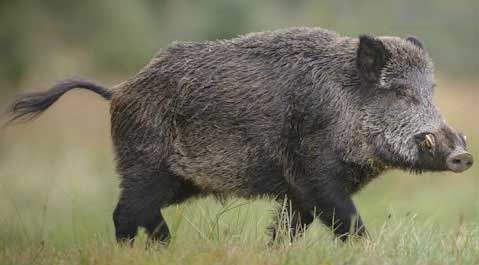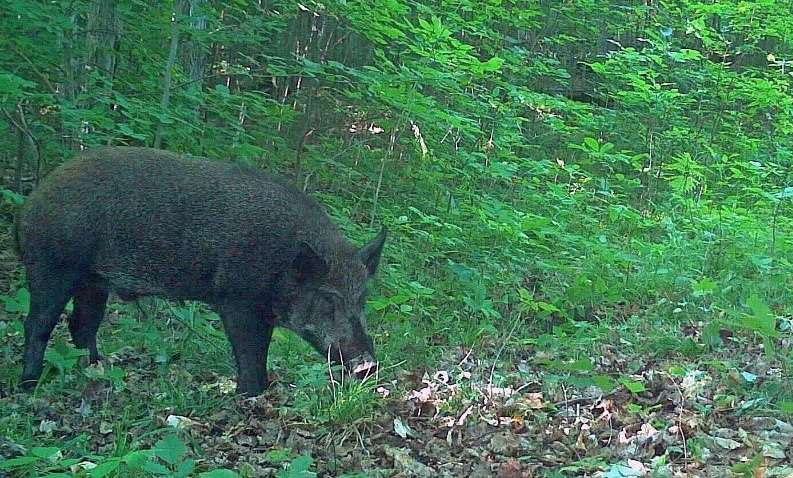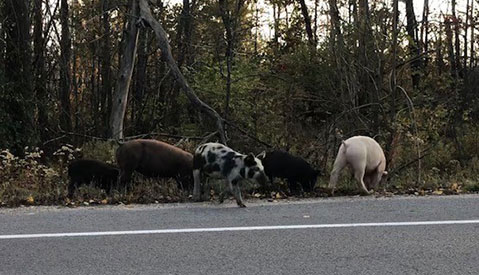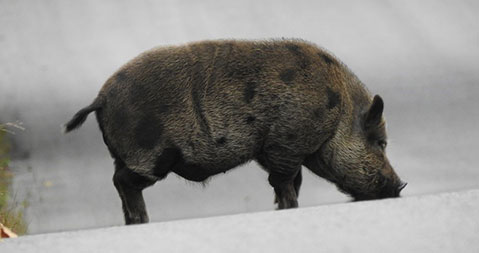Invasive wild pigs in Ontario
Wild pigs are an invasive species in Ontario. Learn about invasive wild pigs in Ontario and how to report sightings.
If you see a wild pig (for example, any pig outside of a fence) or have information about a sighting, please report it using one of the following methods:
- Email: wildpigs@ontario.ca
Tel: 1-833-933-2355 - iNaturalist Ontario wild pig reporting (download the app on a mobile device or register an account using a desktop computer)
Overview and risks
A wild pig is any pig that is outside of a fence that is not contained or under the physical control of a person. This includes free roaming pigs that are:
- domesticated pigs (for example, pot-bellied pigs and farmed domestic breeds, including heritage breeds)
- Eurasian wild boar
- hybrids of domesticated pigs and Eurasian wild boar
Wild pigs are not native to Ontario and can have a negative impact on native wildlife and ecosystems. They have high reproductive potential which means that they can increase in number and spread rapidly, making their impacts more severe. Impacts to the natural environment include:
- preying upon native plants and wildlife
- competing with native wildlife for food, water, and space
- rooting into the ground with their tusks and snouts to dig for roots, tubers, bulbs, worms, insects, slugs, and snails
- trampling and wallowing, which can cause erosion, impact water quality, and degrade natural areas
- spreading disease to wildlife
Wild pigs also pose a significant risk to the agricultural industry. They damage crops, pasturelands and spread disease to livestock, pets and humans. One noteworthy disease, which has not been detected in North America, is African Swine Fever.
Why wild pigs are so invasive
Wild pigs are highly adaptable. For example, even domesticated pigs that normally have very little hair when raised indoors can grow a dense haircoat in a few months to help them to survive cold winter climates.
Pigs are not native to North America, which means they have no natural predators here.
Wild pigs are habitat generalists. This means they can travel great distances and can live anywhere that provides enough shelter, food and water. They can live in agricultural areas, riparian areas, grasslands and forests.
In some areas of the world, invasive wild pigs are not only causing problems in rural landscapes, but they have become urban pests. For example, in certain European cities, groups of wild pigs can be seen roaming through the city, in parks, and rooting through garbage cans.
Once established, invasive wild pigs can spread rapidly. They are prolific breeders and have one of the highest reproductive rates of any mammal. Wild pigs can double their population density in as little as one year. They reach sexual maturity at six months, can have up to two litters each year, and each litter can have between four to ten piglets.
Wild pigs are highly intelligent and can adapt their behaviour in different situations. When wild pigs are exposed to hunting pressure, they flee into new areas and learn to avoid humans. They are quick to reproduce, and populations are known to rebound quickly. This means that hunting for wild pigs is not an effective way of controlling their spread.
Report a sighting
If you see a wild pig or have information about a sighting (dead or alive), please report it using one of the following methods:
- wildpigs@ontario.ca
Tel: 1-833-933-2355 - iNaturalist Ontario wild pig reporting (download the app on a mobile device or register an account using a desktop computer)
Please include as much of the following information as you can:
- the date and time of the sighting
- the location (intersecting roads, landmarks, or GPS coordinates)
- pictures or a video
- the number of pigs and whether piglets were present
- whether the pig appeared to be a:
- domesticated farmed pig
- pot-bellied pig
- Eurasian wild boar
- hybrid
- whether this was an isolated sighting or whether the same wild pig or pigs have been seen multiple times
Contact your local police or call 911 if:
- wild pigs become an immediate danger to people, like showing aggressive behaviour
- you see several wild pigs on a roadway
Notice of collection
The ministry is collecting personal information under the authority of Section 51 of the Invasive Species Act. Personal information may be used by staff to contact individuals regarding potential sightings and locations of wild pigs, or to update individuals on the status of wild pig sightings and management plans. For questions regarding this collection and use of this personal information, please contact:
Science and Research Branch
Trent University, DNA Building
2140 East Bank Drive
Peterborough, Ontario,
K9L 1Z8
Email: wildpigs@ontario.ca
Status of invasive wild pigs in Ontario
Read our annual reports for information on invasive wild pig sightings in Ontario:
Ministry research evaluating potential sources of invasive wild pigs in Ontario tells us that the main source of wild pigs in the province is pigs escaping from captivity. There is currently no evidence to suggest that there are established populations of wild pigs that are breeding and self-sustaining in Ontario, and we must keep it that way.
The least costly and most effective approach for managing wild pigs is to act early. Ontario is taking a proactive approach to address this serious threat. We are working with experts from other jurisdictions and relevant agencies and organizations to implement actions that are outlined in Ontario’s Strategy to Address the Threat of Invasive Wild Pigs (PDF).
Ask the expert video
We continue to collect and monitor reports of invasive wild pig sightings from the public.
Based on the sightings you report, we do on-the-ground follow up in areas where reports suggest a high likelihood that wild pigs are present.
At these locations, ministry staff:
- engage with residents to learn as much as possible about wild pig activity
- set up trail cameras to detect whether wild pigs are still in the area
- where appropriate, trap and remove invasive wild pigs from the natural environment
We ask that you continue to report sightings of wild pigs to wildpigs@ontario.ca,
Download Ontario’s Strategy to Address the Threat of Invasive Wild Pigs (PDF)
What wild pigs look like
- Scientific name: Sus scrofa
- Native continent: Eurasia and North Africa
- Classification: hoofed mammal
- Typical colour and markings:
- adults: black, grey, brown, red, white (highly variable)
- piglets: may be solid, striped or spotted
- Wild pigs:
- The appearance of wild pigs can vary substantially from resembling domesticated pigs to Eurasian wild boar. They can exhibit many colour variations, ranging from very dark to light, and may have spots.
Wild pigs may have the following features, but they can be quite variable:- long snouts
- large tusks
- wedge-shaped heads
- coarse hair
- length: 3.5–5 ft
- height: 2–3 ft
- weight: 30–420 lbs
- The appearance of wild pigs can vary substantially from resembling domesticated pigs to Eurasian wild boar. They can exhibit many colour variations, ranging from very dark to light, and may have spots.
Photos of invasive wild pigs
The term ‘wild pig’ encompasses several types of swine that are all the same species, (Sus scrofa) and their appearance can vary substantially:
Invasive wild pigs with the typical features of Eurasian wild boar:

Photo credit: MNR.
Photo credit: MNR.

Photo credit: MNR.
Invasive wild pigs with the typical features of domesticated pigs:
Photo credit: Scott Brazeau.

Photo credit: Maureen Anderson.
Invasive wild pigs with the typical features of pot-bellied pigs:

Photo credit: Rick Alexander.

Photo credit: Submitted photo.

Photo credit: Debbie Ervine.
Pig ownership
The risks posed by invasive wild pigs to Ontario’s natural environment and agriculture industry remains high. To address these risks and prevent the establishment of invasive wild pigs in Ontario, changes have been developed under the Invasive Species Act, 2015.
Pigs are regulated as a restricted invasive species, meaning:
- live pigs are not permitted in provincial parks or conservation reserves
- it is illegal to release any pig into the natural environment
What to do if your pig escapes or is released
If a pig escapes or is otherwise released, owners must:
- Immediately notify the ministry at wildpigs@ontario.ca or
1-833-933-2355 . - Capture or kill the pig as soon as possible.
- Email wildpigs@ontario.ca or call
1-833-933-2355 to tell us:- when the pig was captured or killed
- the location where the pig was captured or killed
- the number of pigs captured or killed
Learn more about:
- Dealing with escaped livestock in your community
- Fencing for outdoor pig production
- Small scale pig production
Eurasian wild boar and their hybrids
Based on research from the US, Eurasian wild boar and their hybrids play a greater role in the establishment and spread of wild pigs relative to domesticated breeds (for example, breeds of Sus scrofa domesticus). They have certain characteristics that make them more likely to survive in the wild and successfully reproduce.
To address this risk, the import, possession, transport, propagation, lease, trade, buying and sale of live Eurasian wild boar and their hybrids is illegal in Ontario.
For more information on the prohibition of live Eurasian wild boar and their hybrids in Ontario, read Ontario's Strategy to Address the Threat of Invasive Wild Pigs (PDF) and the Invasive Species Act, 2015
Note that the prohibitions related to live Eurasian wild boar and their hybrids do not apply to:
- domesticated pigs (for example, Sus scrofa domesticus), including commercial and heritage breeds of pigs
- pot-bellied pigs
Hunters and property owners
Hunting pigs in Ontario is illegal.
For more detailed information on the prohibition of hunting pigs in Ontario, please view Ontario's Strategy to Address the Threat of Invasive Wild Pigs (PDF) and the Invasive Species Act, 2015.
Landowners (or agents acting on their behalf) have the right to protect their property from damage caused by pigs, including for the purpose of maintaining biosecurity. Consideration should be taken that the pigs may be owned and are being sought for recapture by their owners. To learn what to expect from animal owners in your rural area and how to return escaped farm animals, see Dealing with escaped livestock in your community by the Ontario Ministry of Agriculture, Food and Rural Affairs.
A person who captures or kills a pig for protection of property must immediately notify the ministry by emailing wildpigs@ontario.ca, or phoning
If you shoot a wild pig for protection of property, it is your responsibility to ensure:
- the pig is a wild pig
- you are following all relevant federal, provincial, and municipal legislation regarding trespass, licensing and discharge of firearms

